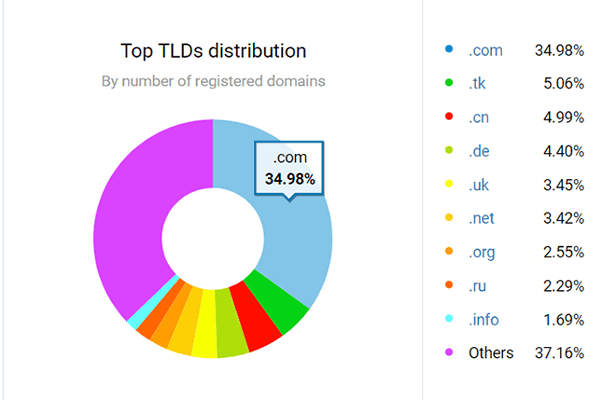18 Web Hosting Statistics For 2024: What Is The State Of The Hosting Industry?

Web hosting services are the cornerstone of the internet as we know it today.
Without web hosts, we wouldn’t be able to access the online resources, social media sites, and shopping websites that we all rely on daily.
To give you a better idea about the current state of this vital sector that powers the modern, digitally connected world, we’ve compiled a list of 18 data-backed web hosting statistics.
These stats will shed some light on the current size of the web hosting market, reveal the companies that dominate the space, and highlight some new trends in the industry.
Editor’s top picks – web hosting statistics
These are our most interesting statistics about web hosting:
- There are more than 1.8 billion websites globally. (Source: InternetLiveStatistics)
- GoDaddy is the most popular web hosting service provider. (Source: HostAdvice)
- Cloud hosting is expected to grow 18.3% per year. (Source: Fortune Business Insights)
General web hosting statistics
Here are some general web hosting statistics that shed some light on the market size and the current state of the hosting industry.
1. There are more than 1.8 billion websites globally
According to InternetLiveStatistics, there are more than 1.8 billion websites and this number is growing every second.
This number refers specifically to websites that resolve to an IP address. However, this can include parked domains. It is believed that less than 25% of these websites are active.
Source: InternetLiveStatistics
2. The global web hosting industry is estimated to be worth $71.1 billion
According to statistics gathered by Global Industry Analyst, the total worth of the web hosting industry is more than $70 billion. Since the pandemic, the demand for web hosting has been growing, so the industry is expected to grow rapidly over the next five years.
Source: Global Industry Analysts, Inc.
3. This figure is expected to rise to over $150 billion by 2026
The same study by Global Industry Analysts predicted that the worth of the global web hosting industry would more than double by 2026. That’s some serious rapid growth, but as demand for websites and hosting providers are always increasing, this prediction seems extremely likely.
Source: Global Industry Analysts, Inc.
4. The US has over 50 million hosted domains
The US has the highest number of hosted domains of any country, with over 50 million in total. The country with the next highest amount of domains is China, which has over 16 million hosted domains in total.

Source: Domain Name Stat
5. The most expensive domain name ever sold cost $872 million
It’s possible to get your hands on a domain name for less than a dollar, but the more coveted domain names are worth a lot. According to GoDaddy, the most expensive domain name ever sold was cars.com.
Although the sale was not publicly reported, this domain was reported to have been worth $872 million. The most expensive publicly reported sale was carinsurance.com, which sold for just under $50 million.

Source: GoDaddy
Web hosting companies statistics
Next, let’s take a look at some web hosting statistics that pertain to the leading players in the space. Here are some stats that can help you learn more about the most popular web hosting providers and companies across the world.
6. GoDaddy is the most popular web hosting service provider
GoDaddy is the leading web hosting service provider in the market, according to data gathered by Host Advice. It’s used by 10.49% of all websites worldwide. Google Cloud Platform is the second most popular provider, trailing behind on just 6.10%.
10% might not seem that impressive, but the web hosting market is scrappy – no single company dominates the space. Instead, market share is distributed widely across dozens of hosting companies.

While GoDaddy is the most popular web hosting, it’s not always the best. If you’re looking for hosting, you may want to consider these GoDaddy alternatives.
Source: HostAdvice
7. GoDaddy hosting costs anywhere between $1 and $179.99/month
GoDaddy holds the top spot when it comes to web hosting thanks to its wide range of hosting packages. They cater to everyone from budget bloggers to businesses that require a dedicated hosting server. Their dedicated server packages cost more than $150/month.
Source: GoDaddy
8. 5% of all websites are hosted by a NewFold Digital brand
If you didn’t already know, NewFold Digital is the parent company behind a bunch of popular web hosting brands, including Bluehost, HostGator, Web.com, Register.com, and more. They’re also known as Endurance International Group. While they may not have quite as big a share as GoDaddy, they’re another big player in the web hosting market.

Source: W3Techs
9. HostGator is the most popular NewFold Digital web hosting platform
Of all the websites hosted by NewFold Digital (Endurance International Group), 32.9% use HostGator. This makes it their most popular brand. Bluehost comes next at 24.7%, followed by Endurance at 13%.

Source: W3Techs
10. The most popular hosted website solution is Wix.com
Many companies are evolving to provide all-in-one hosting solutions that include website building tools, managed hosting, and more. The most popular hosted website solution is Wix.com, which powers over 3.8 million websites, which is around 30% of the hosted solution industry.

Source: Built With
Domain name statistics
Many web hosting service providers double up as domain name registrars. Here are some domain name statistics that reveal some useful insights into the most popular domain names and the leading registrars.
11. 34.98% of domains are .com domains
This shouldn’t come as much of a surprise. As the de facto global domain extension, .com is the largest top-level domain in the world by a long way. It was one of the original TLDs (alongside .edu, .gov, .org, .net, .int, and .mil) available when the internet was first released and has become almost synonymous with the web.
Bagging yourself a .com domain lends your business an air of credibility that other domain extensions just don’t provide.

Source: Domain Name Stat
12. The second most popular domain TLD is .tk
Over 5% of all TLDs are .tk domains, making it the second most popular domain extension after .com. This might come as a surprise, given that .tk is the regional extension for Tokelau – a tiny island territory of New Zealand with a population of just 1,400.
But there’s a dark reason behind this unexpected event. It turns out that the likely reason that there are so many .tk domains is that it’s the extension of choice for internet scammers. The Global Phishing Report found that a huge number of phishing emails originate from .tk domains that have been illegally registered by hackers in China.

Source: Domain Name Stat / Pacific Trade Invest
13. There are over 363 million domain name registrations across all TLDs
This was as of the first quarter of 2021, according to research by Verisign. That means that there’s 1 domain name for every 20 people on earth and shows just how enormous the enormous scale of the internet really is.
Source: Verisign
14. GoDaddy is the leading domain name registrar
Interestingly, GoDaddy isn’t only the most popular web hosting provider – it’s also the most popular domain name registrar. 14.5% of all domain name registrations go through GoDaddy. Namecheap is their closest competitor but trails far behind with just 2.78% of registrations.

Source: Domain Name Stat
15. .info is the most popular new gTLDs
New generic top-level domains are newer, less popular domain name extensions like .info, .tech, .biz, .top, etc.
As the internet has matured, the domain space has become crowded and good .com domain extensions have become very hard to come by. New gTLDs provide an option for businesses that can’t secure their chosen domain name in a more popular domain format.
Of all new gTLDs registered, 10% opted for a .info domain, making it by far the most popular extension. .xyz was the next most popular extension, accounting for around 8% of registrations.
Source: Domain Name Stat
16. The average cost of a domain name is $10-$15 annually
According to domain.com, it costs around $10-$15 annually to purchase and renew a domain name. However, bear in mind that if you’re after a specific domain name that is considered to be more valuable than the average .com site, it can cost a lot more than that. Highly sought-after domain names can set you back thousands – or even millions – of dollars.
Source: Domain.com
Web hosting trends
The web hosting industry is quickly evolving and adapting to meet the demands of web users. Here are some web hosting statistics that highlight some current and expected trends related to web hosting.
17. Cloud hosting is expected to grow 18.3% per year
According to industry forecasts, cloud hosting is expected to show a compound annual growth rate (CAGR) of over 18% per year between 2019 and 2025, making it the fastest-growing hosting type.
Cloud-based web hosting technology offers scalable, flexible pricing models with hosting resources provided on-demand based on website traffic. It’s a very convenient option for expanding businesses that need flexible hosting solutions. As a result, cloud hosting is experiencing rapid growth and propelling the market expansion of the wider hosting industry.
Source: Fortune Business Insights
18. ‘Green’ hosting is growing rapidly
Green web hosting providers use eco-friendly initiatives to reduce the carbon footprint of their data centers. As climate change awareness has grown, and with activist movements like the Extinction Rebellion gaining steam, more and more businesses are under pressure to project a green, climate-conscience image. As a result, demand for greener hosting solutions is growing.
Source: Daily Host News
Wrapping it up
That wraps up our collection of the latest web hosting statistics. By now you should have a good idea of the state of the web hosting industry and where it is heading.
Looking for more stats? Try one of these articles:
